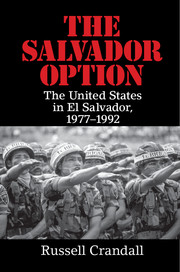Book contents
- Frontmatter
- Dedication
- Epigraph
- Contents
- List of Figures
- List of Organizations
- Acknowledgments
- 1 Introduction
- PART ONE EL SALVADOR IN THE COLD WAR
- PART TWO JIMMY CARTER
- PART THREE RONALD REAGAN
- PART FOUR GEORGE H. W. BUSH
- 39 Elusive Justice
- 40 Pessimism
- 41 Bush Arrives
- 42 Bush, Cristiani, and the 1989 Vote
- 43 Guerrilla Second Final Offensive, November 1989
- 44 Jesuit Killings
- 45 SAMs
- 46 United Nations and Peace
- 47 Demobilization
- PART FIVE POSTWAR
- Notes
- Bibliography
- Index
42 - Bush, Cristiani, and the 1989 Vote
from PART FOUR - GEORGE H. W. BUSH
Published online by Cambridge University Press: 05 June 2016
- Frontmatter
- Dedication
- Epigraph
- Contents
- List of Figures
- List of Organizations
- Acknowledgments
- 1 Introduction
- PART ONE EL SALVADOR IN THE COLD WAR
- PART TWO JIMMY CARTER
- PART THREE RONALD REAGAN
- PART FOUR GEORGE H. W. BUSH
- 39 Elusive Justice
- 40 Pessimism
- 41 Bush Arrives
- 42 Bush, Cristiani, and the 1989 Vote
- 43 Guerrilla Second Final Offensive, November 1989
- 44 Jesuit Killings
- 45 SAMs
- 46 United Nations and Peace
- 47 Demobilization
- PART FIVE POSTWAR
- Notes
- Bibliography
- Index
Summary
We say we are here to fortify democracy. Well, hell, we could be doing that forever.
– U.S. Embassy official, 1989We have time. All the time it takes.
– Fermán Cienfuegos, FMLN commander, 1989“Their Message Is No to Elections”
In a notable development in the lead-up to the March 1989 presidential vote, FDR members Guillermo Ungo and Rubén Zamora returned to their country after eight years of self-imposed exile to run in the elections, which they did as part of the Democratic Convergence (Convergencia Democrática, CD), an alliance of leftist groups. Interestingly, the FMLN's increasingly aggressive tactics – including the escalated kidnapping of Christian Democratic mayors across the countryside – forced a rift with the nascent Convergence movement. The redoubtable Zamora commented, “We believe the FMLN, the same as the Army, is obligated to abide by certain rules, such as the Geneva convention, to protect civilians. Car bombs, attacks on houses of officials and killing mayors are not acceptable.”
Convergence leaders also contended that the guerrillas’ efforts to disrupt the presidential elections were not effective, as evidenced by Salvadorans in recent history coming out to vote despite turmoil. For Convergence organizer Hector Silva, the FMLN was paying an enormous political price for targeting the elections. “Their [guerrillas’] message is no to elections. They are talking insurrection, but the elections are going to take place. The FMLN must find meaning for what the vast majority of Salvadorans will be doing in two months – voting.” In a sobering reminder of how the election was unfolding amid the ongoing war, the Convergence presidential candidate Guillermo Ungo campaigned wearing a bulletproof vest.
Rattled by the Convergence's participation in the elections, in late January the FMLN released a new peace plan that indicated the rebels would take part in the vote if it was postponed for six months and they were provided security guarantees. The deft plan put the Duarte administration in a bind since rejecting it would be categorically difficult now that the FMLN appeared to have dropped its demands for a power sharing government. As one Christian Democrat operative quipped, “The proposal is politically brilliant.
- Type
- Chapter
- Information
- The Salvador OptionThe United States in El Salvador, 1977–1992, pp. 421 - 430Publisher: Cambridge University PressPrint publication year: 2016

